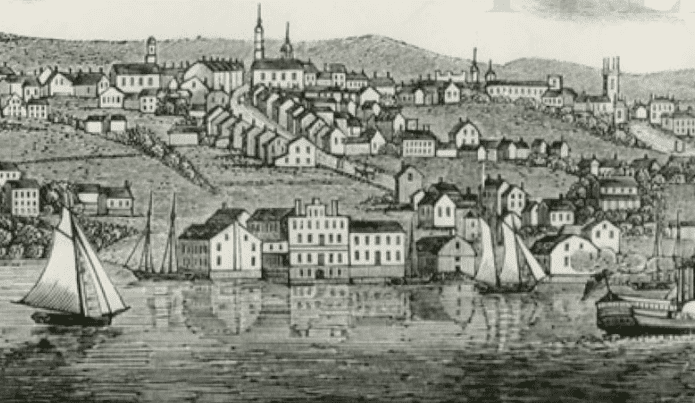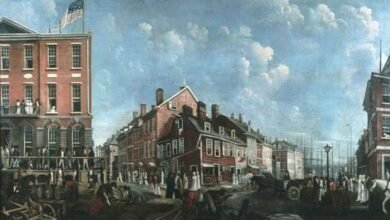Paraclete Potter: Poughkeepsie Publisher & Politician


 In the first decades of the 18th century, Paraclete Potter was a successful newspaper publisher, bookseller, investor, and civic-minded entrepreneur based in Poughkeepsie, New York.
In the first decades of the 18th century, Paraclete Potter was a successful newspaper publisher, bookseller, investor, and civic-minded entrepreneur based in Poughkeepsie, New York.
He lost his money in a real estate crash in 1840, but he’d made political friends over the years, and got a patronage appointment in Wisconsin, where he rebuilt his life.
Potter’s career is interesting; but even more remarkable is the way it intertwined with historically significant events and changes for his era: Booms. Busts. Railroads. A New York whaling company. A federal Currency crisis. War, and Presidential politics. Debates about slavery. New methods for printing and distributing books. Indentured servitude.
If you could time-travel, and sit in the library section of his bookstore, perusing his newspapers’ ads and editorials, and listen to the local worthies conversing on the side, while also observing what was bought and sold at the front counter — you’d have a good window into Paraclete Potter’s times.
Paraclete Potter (1784 – 1858) came from a big family, in a long line of Potters that settled in Rhode Island in colonial times. (There were numerous other Potters, with different family trees, who also settled in Rhode Island and other New England states.) A number of these Potters made their way over time to Dutchess County, New York, as Paraclete’s parents did, in time for the birth of their fifth (of nine) children.
Joseph Potter, Paraclete’s father, became a successful farmer in Beekman, NY. He was active in community activities, such as fundraising for health causes, and as a member of the Dutchess Agricultural Society. He was also elected to the New York State Assembly in 1797 and in 1813.
Once, however, Joseph got scammed — centuries before the term was invented — by an “identity theft.” At Joseph’s stables in 1804, a con-man presented a card identifying himself as a Bowman, a well-off family the Potters knew, and the thief was “lent” a horse. The same thief brazenly ran same trick on others in the region, using faked names, recognized by those victims.
Nonetheless, Joseph’s connection with the Bowmans likely helped his son Paraclete get started in publishing. Not long after the horse incident, 1805, a Godfrey Bowman, who was three years older than Paraclete, became a partner in the Poughkeepsie Journal. By January 1806, the paper was being published under “Bowman and Potter”; then, by 1809, Paraclete owned it, outright.
Newspapers and Politics
That Poughkeepsie Journal was originally established in 1785 — three years before the ratification of the U.S. Constitution. So, newspapers in those times took political stands on issues that were often core foundational questions for the new country itself, such as how much power should be vested in the central, federal government, versus how much devolved to the states.
Well into Potter’s involvement with the paper, the Journal supported the cause of the Federal party (Federalists), in favor of a strong central government; and it opposed the Democratic-Republican (Democratic) party of Presidents Jefferson and Madison.

 Other Poughkeepsie papers passed into and out of into existence over the years, and supported alternative positions. In 1812, Potter and his paper strongly opposed the War against Great Britain, believing it would be disastrous for American trade and businesses, and that, militarily, the country was unprepared.
Other Poughkeepsie papers passed into and out of into existence over the years, and supported alternative positions. In 1812, Potter and his paper strongly opposed the War against Great Britain, believing it would be disastrous for American trade and businesses, and that, militarily, the country was unprepared.
Potter’s political activities were not limited to his editorials. From 1810-1818, he attended meetings of the Federal Republican Electors Committee for Poughkeepsie, which drafted resolutions and supported nominations, such as for State Governor. Potter was appointed Secretary for the committee in 1810, and subsequently for other roles.
By 1828, however, as recalled later by a contemporary editor (Poughkeepsie Eagle, May 5, 1849), “the old parties were broken up, and there was a general gathering of leaders from all sides under the [Andrew] Jackson standard.”
Potter’s Journal joined the bandwagon. Jackson advocated for states’ rights, as did the Democratic-Republicans; but Potter liked Jackson’s support for a strong federal, executive, and his “common man” populism.
Potter also served on several committees advocating for local issues: For example, in 1816, a committee lobbied the State to create a turnpike route that served Poughkeepsie and some other towns. In 1825, another committee advocated for a new canal or railroad route that would serve Poughkeepsie.
Then, in 1834, Paraclete Potter stepped down as the owner and editor of the Journal, which had become, by then, a Democratic paper. But he stayed involved in party politics. He was a delegate in the Dutchess County Democratic Republican Convention in 1835, where the nomination of Andrew Jackson’s Democratic ally Martin Van Buren for President was endorsed.
Potter’s support for Jackson and Van Buren wavered, however, in response to their monetary policies, which many believed contributed to serious financial disruptions, during the Panic of 1837. That nation-wide economic crises included bank failures, loan losses, and crashes in real estate and stock market prices.
Potter objected, especially, to a federal law “prohibiting the circulation of bills under the denomination of $5,” against which Potter railed in published statements of disapproval, co-signed by many others, in the Poughkeepsie Journal, in 1837 and 1838.
The law’s intent was to help stabilize the country’s monetary system at a time when many banks issued their own paper currencies of inconsistent values; so, the law encouraged payment using stable-valued coins made of precious metal, instead.
But for many businesses and everyday users, it was impractical to comply. More ominously, some felt, the law was an abuse of the federal Executive’s power, since it overruled banking institutions of the individual States.
Under such pressures, the controversial law was not implemented.
Printing, Binding, Selling Books and More
The ideals of the American Revolution, wrote historian Richard Brown, promoted an informed citizenry, who “actively patronized the press, both as authors and as readers.”
Literacy rates increased in those times, not just for professionals and politicians, but for ordinary men and women as well. They sought all manner of materials: From newspapers, almanacs, and the Bible; to religious works for ministers, and law pamphlets for lawyers, and medical references; to novels, history and geography books.
Paraclete Potter’s bookstore carried all of these, and more.
Potter’s newspaper business, however, did not yet deal with books when he got started in 1806. It was Chester Parsons, who moved to Poughkeepsie in 1805, who “respectfully [announced his new] business of Bookbinding and Bookselling.” He sold many varieties of books, and also many related products, such as pens and ink, high-quality letter paper, receipt books, and blank journals.

 Within six months, the two businesses combined, partnering under the name Bowman, Parsons, & Potter. This was another way that Potter was illustrative of his times. It was cost-effective, then, to combine book selling, printing, and binding, as historian James Green explains:
Within six months, the two businesses combined, partnering under the name Bowman, Parsons, & Potter. This was another way that Potter was illustrative of his times. It was cost-effective, then, to combine book selling, printing, and binding, as historian James Green explains:
“Books were expensive to import (if published abroad), or to produce, market and distribute across a growing nation. Many British books did not have U.S. copyright protection, so those could be reprinted and bound by local sellers, themselves.
“For American books under copyright, a system of exchanges saved small publishers from the costs of each having to print, bind, and transport large quantities of their books from their catalogs.
“Instead, they’d cooperate — to reprint, bind, and sell each others’ books, for their own local markets; this required smaller print runs, and less shipping. An alternative for bigger publishers was to send their books to sellers as sheets, to be bound at the local bookstores.”
For the most part, writes rare-book collector Bruce E. McKinney, Paraclete Potter’s press was “in the business of reprints”; but he also published some original books. These included school books, a book of military tactics, and legal-statute guidebooks.
But from its beginning, Paraclete’s bookstore expanded its wares beyond just paper- and book-related services and products, such as pamphlets. If you lived in that era, perhaps you’d have bought Dr. Bateman’s Pectoral Drops there, or Essence of Bergamot, or Turlington’s Original Balsam of Life.
Or, you might have picked up garden seeds (from “a fresh supply of the last year’s growth”); or bought a “razor strop,” if you wanted to sharpen a surgical scalpel or a penknife. And up at the front counter, you could buy a lottery ticket for a good, community cause — like a Board of Health lottery, having a grand prize of $40,000.
Potter’s front counter also became something of contact point for the surrounding region. When Ezra Ingerfoll lost his watch in June 1806, he offered its finder a reward of $5 for its return: Just drop it off at the bookstore, he requested.
Another person wanted to sell, before he moved from the country in 1817, a pair of “sound, active BAY MARES, with Waggon Harness — Pleasure Sleigh, &c.”, and a straw cutter. So, he published an ad in the Journal, asking anyone who’s interested to contact the bookstore.

 Reading that same ad today, however, it is alarming to see some additional “property” that was listed for “sale”: “Eight years time” of a 20-year-old Black man.
Reading that same ad today, however, it is alarming to see some additional “property” that was listed for “sale”: “Eight years time” of a 20-year-old Black man.
It’s unlikely that this young man was, technically, a slave — although, regrettably, in 1817 there were still slaves in New York State, including in Dutchess County.
New York legislated in 1799 an “Act for the gradual abolition of slavery”, which specified that “children born to a slave mother after July 4, 1799 were declared legally free — but not until male children had turned 28, and females 25.
Slaves born before that date … were redefined as indentured servants.” Born earlier than 1799, the man in that ad had a “contract” ending at age 28, similar to the terms in that Act.
He might on the other hand, have been born free — but redirected from his family to “pauper apprenticeship,” for supposedly his “improvement,” sustenance, and some education.
Ruth Herndon and John Murray explain that placing children into indentures, or legally binding contracts, was not uncommon in that era for children living in poverty, white as well as black. But white children’s indentures would typically end younger, at age 21 instead of 28; and white males likely received more literacy education and, often, trades-training.
Regarding slavery, Potter came to believe it was a “great evil”, but he was not an abolitionist. Early on, in fact, his paper accepted some advertisements for the “sale” of a person (not the sale of their “time”). In the 1830’s, he became active in a chapter of the American Colonization Society, which encouraged free Blacks to settle in Africa, in what became Liberia.
Many African-Americans, like Frederick Douglass, and abolitionists, like William Lloyd Garrison, abhorred the colonization idea on numerous grounds. These included: the emigrants’ not-truly voluntary participation; the fact that, for most Blacks, America was the only home they knew; and serious health and mortality risks for many who embarked. Yet, in those times, even Garrison himself, and others, were attracted initially to the Colonization idea, for sympathetic, if naïve, reasons.

 Just such discussions probably occurred in Potter’s own bookstore. A newspaperman who once apprenticed in Potter’s Journal, Isaac Platt, reminisced that “most of his early education was obtained in the printing office and in Paraclete Potter’s bookstore…. [The bookstore] was a great village institution, a sort of club where all those who were fond of literature and of discussion were wont to gather.”
Just such discussions probably occurred in Potter’s own bookstore. A newspaperman who once apprenticed in Potter’s Journal, Isaac Platt, reminisced that “most of his early education was obtained in the printing office and in Paraclete Potter’s bookstore…. [The bookstore] was a great village institution, a sort of club where all those who were fond of literature and of discussion were wont to gather.”
Discussants were surrounded not just with books for sale, but with books “in the different departments of literature” that constituted Potter’s subscription lending library.
Finally, there was one more class of items found in Paraclete’s bookstore — presumably in a back storage area: namely, items accepted “as payment of debt.” Potter posted notices, occasionally, that he’d accept “at fair market prices” grains, pork, wood, butter, and cheese, and other items, in payment of his customers’ debts to him.
Civic-Minded Activities and Investments
Starting when he was about age 30, Paraclete began to take on roles in corporate governance — both in the education sector, and on corporate boards. In 1814, for example, he became a trustee for the Lancaster School Society, which was newly incorporated to follow “the latest” educational ideas.
Again, in 1836, he served as a trustee for the Poughkeepsie Collegiate School, which had just been founded “on Philosophical principles… [attuned] to the nature of the juvenile mind.”
For numerous years, he also sat on the Board of Directors of the Middle District Bank, founded in 1811.
By around 1830, Potter was actively involved in what became the “Poughkeepsie Improvement Party.” Fellow members included Nathaniel P. Tallmadge, a former bank director, who was later a state senator (1827) and then a United States Senator (1833).

 One prong of their mission was to encourage (and help fund) Poughkeepsie’s becoming, as Edmund Platt writes, “an up-to-date, model village…. [with a central section all paved] with cobblestones and the sidewalks paved with brick, [plus other] efforts.… to make the town as attractive as possible.”
One prong of their mission was to encourage (and help fund) Poughkeepsie’s becoming, as Edmund Platt writes, “an up-to-date, model village…. [with a central section all paved] with cobblestones and the sidewalks paved with brick, [plus other] efforts.… to make the town as attractive as possible.”
Besides this, they invested and served as directors in ventures which Platt calls “daring in the extreme. Among them [was starting] a locomotive factory, … long before there was any railroad in the neighborhood.” (It worked out, unfortunately, as you might expect.)
They were also involved in two whaling companies: The Poughkeepsie Whaling Company, and the Dutchess Whaling Company.
All this activity helped precipitate a real estate boom in the region, with many people investing in land and making money – until that Panic of 1837.
Potter, and most other members of the Improvement Party went bust. He still had his “day job” in book binding, and then he followed several others in the Improvement Party to the Wisconsin Territory. There, he was appointed Land Register for the Territory in 1841, and his colleague, Senator Tallmadge became governor there in 1844.
Out west, Potter kept up similar types interests as before. Newspaper clippings show his involvement, for instance, in another railroad, and efforts on behalf of a local school. And he stayed interested in politics.
When, in his last years, he became a corresponding member of the Wisconsin State Historical Society, it was very fitting. Paraclete Potter was a man whose whole life seemed to reflect his momentous historical times.
As related in his memoir, Seeing Both: A Memoir of Chances, William M. Goodman was raised in New York State, 60 miles north of New York City. He worked briefly near Poughkeepsie, once home of Paraclete Potter’s newspaper and bookstore. William later obtained a doctorate in Philosophy, and has loved researching and writing on diverse topics—from philosophy to analytical statistics.
Illustrations, from above: Poughkeepsie’s riverfront, ca. 1840; Parcalete Potter’s Poughkeepsie Journal in 1806; the eighth edition of Amelia Simmons’ American Cookery, published by Paraclete Potter in Poughkeepsie in 1815, was originally issued in Hartford, 1796, and considered the first American cookbook authored and published in the US; November 5, 1817 indentured servitude advertisement in the Poughkeepsie Journal; The Infantry Exercise of the United States Army abridged for the use of the militia of the United States (published by Potter in 1824); and “A map of the incorporated village of Poughkeepsie, Dutchess County, state of New York / surveyed, drawn, and published by Henry Whinfield, civil engineer,” 1834.
Source link





